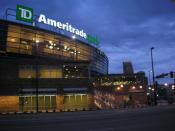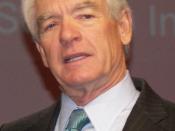Finance 5204
Managing Corporate Capital Investment and Capital Structure
Case1
Cost of Capital at Ameritrade
By:
Elaine Huang
Jonathan Hudson
Christopher Lenker
Ameritrade does not have a beta estimate as the firm has been publicly traded for only a short time period. Exhibit 4 provides various choices of comparable firms. What comparable firms do you recommend as the appropriate benchmarks for evaluating the risk of Ameritrade's planned investments? Why?
We recommend using the following firms in the Discount Brokerage Industry: Charles Schwab Corporation, E-Trade, Waterhouse Investor Services, and Quick and Reilly Group, in order to estimate the Beta of the firm. We have chosen these four firms as comparables to Ameritrade because they compete within the same realm of business as Ameritrade. We draw this conclusion based off several references from the text. The first reference demonstrates Ameritrade as a discount broker by stating, "Full-service brokers were less sensitive to market movements than deep-discount brokers like Ameritrade."
Another assertion which illustrate Ameritrade's competition is, "â¦competitors such as Charles Schwab and E*Trade did not follow Ameritrade's lead and try to compete on price." These arguments along with others from the text provide convincing evidence that compel us to choose both the discount brokerage industry and Charles Schwab, E*Trade, Waterhouse, and Quick and Reilly Group, in order to accurately measure Beta and likewise risk.
Using the stock price and returns data in Exhibits 5 and 6 and the capital structure information in Exhibit 4 estimate the equity beta òs, asset beta òa and the cost of assets, ka, for (i) discount brokerage firms and (ii) investment services firms as comparable groups, assuming (i) debt beta=0 and (ii) debt beta = 0.25.
Table A | Charles Swab | Quick and Reily | Waterhouse | ||
Bs | 2.297 | 2.2042 | 3.1899 | ||
Debt | 0.08 | 0 | 0.38 | ||
Equity | 0.92 | 1 | 0.62 | ||
i. Ba when Bd = | 0 | 2.11324 | 2.2042 | 1.977738 | 2.0983927 |
ii. Ba when Bd = | 0.25 | 2.13324 | 2.2042 | 2.072738 | 2.136726 |
Rf | 6.61% | ||||
Rm-Rf | 7.2% | ||||
Ka when Bd = | 0 | 21.7184272% | |||
ka when bd = | 0.25 | 21.9944272% |
Table B | A G Edwards | Bear Stearns | Merrill Lynch | MSDW | Paine Webber | Raymond James | ||
Bs | 1.4495 | 1.6893 | 1.8226 | 2.0924 | 1.7648 | 1.4489 | ||
Debt | 0 | 0.5 | 0.52 | 0.53 | 0.53 | 0.04 | ||
Equity | 1 | 0.5 | 0.48 | 0.47 | 0.47 | 0.96 | ||
i. Ba when Bd = | 0 | 1.4495 | 0.84465 | 0.874848 | 0.983428 | 0.829456 | 1.390944 | 1.062137667 |
ii. Ba when Bd = | 0.25 | 1.4495 | 0.96965 | 1.004848 | 1.115928 | 0.961956 | 1.400944 | 1.150471 |
Rf | 6.61% | |||||||
Rm-Rf | 7.2% | |||||||
Ka when Bd = | 0 | 14.2573912% | ||||||
ka when bd = | 0.25 | 14.8933912% |
Explain your choice of inputs to the CAPM in estimating Ka:
We chose the value weighted option because there are firms of varying sizes in the marketplace. The risk free rate is measured as the currently prevailing yield on a government security. We chose the thirty year bond because the expected lives of the companies being analyzed are long term. In addition we chose the data set with the longer term horizon because the amount of data is greater than any other available data set. We feel that the more data that is available the better the prediction of future returns. After choosing the table with the greater amount of data (1929-1996), we chose to use large company stocks for the variable Rm and chose long term bonds for Rf. Since large company stocks capture a greater fraction of the total market capitalization it is a better proxy for the market portfolio. Since the life of the asset being analyzed is long-term, we chose the the long-term government bond yield as Rf.
Explain why the Ba and hence Ka are so different for the two groups:
Full service brokers are less sensitive to changes in the marketplace than discount brokerage. Because of this the diversified nature of full service brokerage we can reasonably expect that their discount rate Ka should be smaller than the discount rate of the deep discount brokerage firms. We observe this to be true and find that full service brokerage firms have a Ka of 14.89% and their discount brokerage counterparts have a Ka of 18.59%.
Estimate the asset beta of Ameritrade by generating return data through December 2000 and compare with your estimate in Q2 based on the method of comparables. Assume a market value debt ratio (debt/value) of 0.14 for Ameritrade.
Table D shows the differences between the historical Beta for Ameritrade and the predicted Beta. Our initial hypothesis that the discount brokerage comparables method is superior to the investment services method is correct. This is illustrated by the observation that the discount brokerage industry's Beta more closely resembles the historical Beta for Ameritrade than the Investment Services Industry.
Table C: Data for Ameritrade taken from the Wharton Website | ||||
Bs | 2.8173 | |||
Debt | 0.14 | |||
Equity | 0.86 | |||
i. Ba when Bd = | 0 | 2.422878 | ||
ii. Ba when Bd = | 0.25 | 2.457878 | ||
Rf | 6.61% | |||
Rm-Rf | 7.2% | |||
Ka when Bd = | 0 | 24.05472% | ||
ka when bd = | 0.25 | 24.30672% |
Table D | Ameritrade | Investment Services | Discount Brokerage | ||
Bs | 2.8173 | ||||
Debt | 0.14 | ||||
Equity | 0.86 | ||||
i. Ba when Bd = | 0 | 2.422878 | 1.062137667 | 2.098392667 | |
ii. Ba when Bd = | 0.25 | 2.457878 | 1.150471 | 2.136726 | |
Rf | 6.61% | ||||
Rm-Rf | 7.2% | ||||
Ka when Bd = | 0 | 24.0547216% | 14.2573912% | 21.7184272% | |
ka when bd = | 0.25 | 24.3067216% | 14.8933912% | 21.9944272% |


